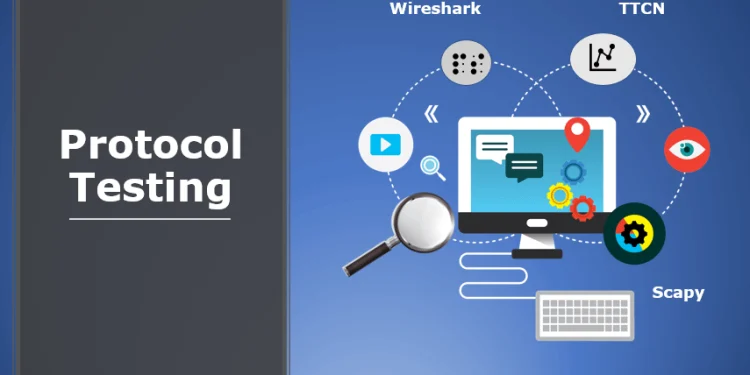In the rapidly evolving world of networking, ensuring that communication protocols operate correctly and efficiently is crucial. Protocol testing, particularly at Layer 2 (L2) and Layer 3 (L3) of the OSI model, plays a vital role in verifying the functionality and performance of network devices and systems. This blog post will delve into the basics of protocol testing, its importance, methodologies, and tools, with a focus on L2 and L3 protocols. By understanding these concepts, you can better appreciate the intricacies of network communication and ensure your network infrastructure is robust and reliable.
Table of Contents
What is Protocol Testing?
Protocol testing involves verifying that communication protocols in network devices or systems function as expected. These protocols define rules for data exchange between network devices, ensuring interoperability and effective communication. Protocol testing ensures these rules are adhered to, identifying any deviations or issues that could affect network performance.
The OSI Model and Protocol Testing
The OSI (Open Systems Interconnection) model is a conceptual framework used to understand and implement networking protocols. It consists of seven layers, each responsible for different aspects of data communication. Protocol testing primarily focuses on Layer 2 (Data Link Layer) and Layer 3 (Network Layer).
Layer 2 (Data Link Layer)
The Data Link Layer is responsible for node-to-node data transfer and error detection and correction. It ensures reliable data transmission between two directly connected nodes and handles framing, addressing, and flow control. Common L2 protocols include Ethernet, PPP (Point-to-Point Protocol), and ARP (Address Resolution Protocol).
Layer 3 (Network Layer)
The Network Layer manages the delivery of data packets across multiple networks. It handles routing, addressing, and packet forwarding. Key L3 protocols include IP (Internet Protocol), ICMP (Internet Control Message Protocol), and routing protocols like OSPF (Open Shortest Path First) and BGP (Border Gateway Protocol).
Importance of Protocol Testing
Ensuring Interoperability
With a myriad of network devices from different vendors, ensuring interoperability is critical. Protocol testing verifies that devices can communicate effectively, adhering to the same set of protocol standards.
Enhancing Network Performance
Identifying and resolving protocol-related issues through testing helps maintain optimal network performance. It ensures data is transmitted efficiently and without errors.
Improving Network Security
Protocol testing can reveal vulnerabilities and security flaws in communication protocols. Addressing these issues helps protect the network from potential attacks and data breaches.
Compliance and Standards
Adhering to industry standards and protocols is crucial for network devices. Protocol testing ensures compliance with these standards, facilitating smoother integration and operation within existing network infrastructures.
Methodologies of Protocol Testing
Conformance Testing
Conformance testing checks whether a device or system adheres to a specific protocol standard. It involves testing the implementation against a predefined set of rules and specifications. Conformance testing ensures that the device behaves correctly under various conditions, following the protocol’s requirements.
Performance Testing
Performance testing evaluates the efficiency and effectiveness of a protocol implementation. It measures parameters like throughput, latency, and packet loss under different network conditions. This testing helps identify bottlenecks and areas for optimization.
Interoperability Testing
Interoperability testing ensures that different devices or systems can work together seamlessly. It involves testing the communication between devices from different vendors or with different protocol implementations. This testing is crucial for multi-vendor network environments.
Negative Testing
Negative testing involves deliberately introducing errors or abnormal conditions to test the robustness of the protocol implementation. It helps identify how the system handles unexpected situations, ensuring stability and reliability.
Tools for Protocol Testing
Several tools are available for protocol testing, each offering unique features and capabilities. Here are some popular ones:
Wireshark
Wireshark is a widely used network protocol analyzer. It captures and analyzes network traffic in real-time, allowing testers to inspect protocol interactions and identify issues. Wireshark supports a vast range of protocols and provides detailed insights into packet data.
Ixia IxNetwork
Ixia IxNetwork is a comprehensive testing solution for validating the performance and scalability of network devices and protocols. It offers extensive L2 and L3 protocol support, allowing testers to simulate realistic network conditions and measure device performance.
Scapy
Scapy is a powerful Python-based tool for network packet manipulation and analysis. It enables users to create, send, and capture packets for testing and debugging purposes. Scapy supports a wide range of protocols and is highly flexible for custom testing scenarios.
Spirent TestCenter
Spirent TestCenter is a versatile testing platform for validating network performance and protocol conformance. It offers extensive protocol support and advanced testing features, including traffic generation, analysis, and automation capabilities.
Ostinato
Ostinato is an open-source packet generator and network traffic generator. It allows testers to create custom packets and simulate network traffic for testing protocol implementations. Ostinato is user-friendly and supports various L2 and L3 protocols.
Steps in Protocol Testing
1. Define Test Objectives
Clearly outline the objectives of your protocol testing, such as verifying conformance, assessing performance, or ensuring interoperability. Defining objectives helps in planning and executing the testing process effectively.
2. Select Appropriate Tools
Choose the right tools based on your test objectives and requirements. Consider factors like protocol support, features, ease of use, and compatibility with your test environment.
3. Create Test Scenarios
Design test scenarios that cover different aspects of the protocol implementation. Include positive and negative test cases to ensure comprehensive coverage.
4. Execute Tests
Run the tests using your selected tools and capture the results. Ensure that the tests simulate realistic network conditions to get accurate insights into protocol behavior.
5. Analyze Results
Analyze the test results to identify any deviations, performance bottlenecks, or interoperability issues. Use the insights to make necessary improvements and optimizations.
6. Document Findings
Document the test process, results, and any issues identified. Proper documentation helps in tracking progress, maintaining transparency, and facilitating future testing efforts.
7. Repeat and Improve
Protocol testing is an iterative process. Continuously refine your testing approach, update test scenarios, and repeat the tests to ensure ongoing compliance, performance, and interoperability.
Conclusion
Protocol testing is a critical aspect of network development and maintenance, particularly at Layer 2 and Layer 3 of the OSI model. By ensuring that communication protocols function correctly and efficiently, protocol testing enhances network performance, security, and reliability. Understanding the importance, methodologies, and tools for protocol testing enables network professionals to create robust and efficient network infrastructures. As networking technology continues to evolve, the role of protocol testing will only become more significant, helping to ensure seamless and secure communication in increasingly complex network environments.


